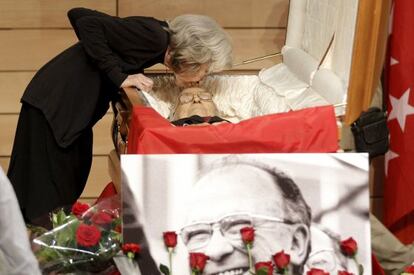Tributes paid to Santiago Carrillo, a key figure in the democratic transition
He “chose coexistence and reconciliation” over party interests, says Rubalcaba

Thousands of people lined up to mourn the loss of the iconic leftist politician Santiago Carrillo on Wednesday, inundating the hall at the headquarters of the CCOO labor union in Madrid where the former leader of the Spanish Communist Party lay in state. Carrillo will be cremated in the capital on Thursday, with his family saying that they will spread his ashes in the sea by Gijón, the Asturian city where he was born in 1915.
Carrillo’s passing on Tuesday heralded the end of an era in Spanish history; the 97-year-old was the last surviving public figure to have actively participated in the Civil War. During the siege of Madrid, Carrillo was appointed councilor for Public Order and served on the capital’s Defense Council. It was as a result of this period that Carrillo’s name would be etched onto the national psyche as a result of the Paracuellos massacre. Carrillo denied direct knowledge of the execution of thousands of Nationalist military personnel and sympathizers but the Franco regime always maintained that he had ordered the massacre.
Many historians agree that although Carrillo probably did not foresee the scale of the atrocity, he was actively involved in the transportation of prisoners from the Modelo jail to their eventual fate in the countryside outside the capital. “Carrillo knew about Paracuellos, but he did not instigate it,” Hispanist Ian Gibson said Wednesday. “[Carrillo] knew perfectly well what would happen at Paracuellos, but the people in charge were the Russian advisors, who had Stalinist methods, terrible and atrocious.”
Deputy Prime Minister Soraya Sáenz de Santamaría of the center-right Popular Party summed up the conciliatory spirit of Carrillo’s later political life, when he became a key figure during the bridge-building period of the transition to democracy after Franco’s death: “There were many shadows and some light [in the 20th century],” said Santamaría at Carrillo’s side. “At this moment, I think that we have to bring to mind the light that was the Transition.”
Carrillo returned clandestinely to Spain after the death of Franco, meeting in secret with Prime Minister Adolfo Suárez and eventually doing a deal by which his Spanish Communist Party (PCE) would be legalized in return for its recognition of the Spanish king. The PCE gained little success in subsequent elections, being eclipsed by the Socialist Party led by Felipe González.
Carrillo is part of the best of our history, the history of the political left”
On hearing of Carrillo’s death on Tuesday, King Juan Carlos paid tribute to a “fundamental figure for democracy” in Spain.
The leader of the Socialist Party, Alfredo Pérez Rubalcaba, paid his respects to a man who “chose coexistence and reconciliation” above the political interests of the Communist Party in the aftermath of the dictator’s death. “Current Spanish democracy owes a lot to Santiago Carrillo.”
United Left leader Gaspar Llamazares criticized those seeking to “tarnish” Carrillo’s political image “at such an inappropriate time.”
“Carrillo is part of the best of our history, of the history of the workers’ movement and the history of the political left,” Llamazares said.
Former Socialist Prime Minister Felipe González spoke of Carrillo’s “number-one priority,” that of “coexistence and peace. He played an extraordinary role [in the Transition], showing political courage, a sense of state and that he was set in reality.”
Tu suscripción se está usando en otro dispositivo
¿Quieres añadir otro usuario a tu suscripción?
Si continúas leyendo en este dispositivo, no se podrá leer en el otro.
FlechaTu suscripción se está usando en otro dispositivo y solo puedes acceder a EL PAÍS desde un dispositivo a la vez.
Si quieres compartir tu cuenta, cambia tu suscripción a la modalidad Premium, así podrás añadir otro usuario. Cada uno accederá con su propia cuenta de email, lo que os permitirá personalizar vuestra experiencia en EL PAÍS.
¿Tienes una suscripción de empresa? Accede aquí para contratar más cuentas.
En el caso de no saber quién está usando tu cuenta, te recomendamos cambiar tu contraseña aquí.
Si decides continuar compartiendo tu cuenta, este mensaje se mostrará en tu dispositivo y en el de la otra persona que está usando tu cuenta de forma indefinida, afectando a tu experiencia de lectura. Puedes consultar aquí los términos y condiciones de la suscripción digital.
Últimas noticias
The complicated life of Francesca Albanese: A rising figure in Italy but barred from every bank by Trump’s sanctions
Half of Scotland is in the hands of 420 property owners
Pinochet’s victims grapple with José Antonio Kast’s rise in Chile
Reinhard Genzel, Nobel laureate in physics: ‘One-minute videos will never give you the truth’
Most viewed
- Pablo Escobar’s hippos: A serious environmental problem, 40 years on
- Why we lost the habit of sleeping in two segments and how that changed our sense of time
- Charles Dubouloz, mountaineering star, retires at 36 with a farewell tour inspired by Walter Bonatti
- Reinhard Genzel, Nobel laureate in physics: ‘One-minute videos will never give you the truth’
- The Florida Keys tourist paradise is besieged by immigration agents: ‘We’ve never seen anything like this’








































